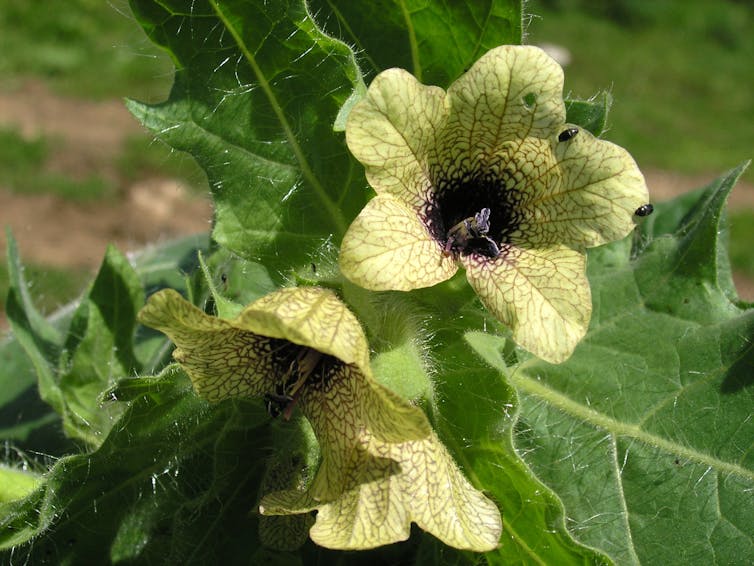Scientists in the Netherlands have discovered a hollowed-out bone containing black henbane seeds at a Roman archaeological site. For centuries, the plant has been associated with medicine and magic.
Black henbane (Hyoscyamus niger) contains toxic and potentially deadly compounds called tropane alkaloids. These compounds include hyoscyamine and scopolamine, which are concentrated in the leaves and seeds and are known for their psychoactive and medicinal properties.
The exciting discovery at Houten-Castellum in the Netherlands has shed light on the intentional collection and use of black henbane seeds during the time of the Roman empire. On excavation of a water pit at the site, dated to about AD70-100, a hollowed-out sheep or goat bone, plugged one end with birch-bark tar, was found filled with over a thousand black henbane seeds.
The bone was interpreted as a container rather than a pipe, since there was no evidence of burning of the seeds. Smoking pipes were also rare in Europe before the arrival of tobacco. At the same archaeological site, a flowerhead of henbane was found with a basket and ceramic cooking pots. These were interpreted as offerings when people abandoned the settlement.
Remains of black henbane seeds have been found in association with other medicinal plants at archaeological sites in north-western Europe. These date from the Neolithic period onwards, including at several Roman sites.
The earliest finds date back to the first farmers in Europe, around 5500-4500BC. It has been suggested that the plant migrated with farming communities, either intentionally or accidentally, as a “weed of cultivation”.
Conclusive evidence of black henbane’s use by people at these sites, however, is usually lacking. This is due to the plant’s habit of naturally growing on disturbed ground across temperate Eurasia and north-west Africa, combined with the fact that henbane produces many seeds.
There is little evidence for the cultivation or medicinal and hallucinatory uses of henbane until the Roman period, although it is mentioned in the Ebers Papyrus from ancient Egypt, around 1500BC.
The extent of use of henbane as a medicine across the Roman empire is unknown, but it may have been common, since it was found in 65 of 83 Roman-period sites in the Netherlands.
BIAX Consult via Free University of Berlin
Archaeological finds from a first century AD hospital at a Roman fortress in the Rhineland included burned seeds of black henbane along with several other medicinal plants – providing strong circumstantial evidence that people in Roman Rhineland were aware of, and using, black henbane for its medicinal properties.
Treating everything from fever to flatulence
Surviving medical texts from the Roman period also provide details of how henbane was used. The Roman natural historian Pliny the Elder and the Greco-Roman physician Dioscorides both wrote about the properties of henbane in the first century AD.
In his famous herbal, De Materia Medica, Dioscorides referred to three types of henbane: white, yellow and black. The black type is probably black henbane, while the yellow and white types are probably another species, Hyoscyamus albus.
Dioscorides wrote that both yellow and black henbane can cause delirium and sleep, but he considered that black henbane was best avoided due to its stronger effects.
He also described the use of henbane seeds, taken in a juice for pain relief or for treatment of mucus and disorders of the womb. The leaves could be applied to the body to soothe pain or were taken in liquid to lower a fever. If boiled, the leaves were said to cause disturbances to the senses.
Pliny the Elder described four types of henbane in his book Naturalis Historia, including one with black seeds and purple flowers that could cause insanity and giddiness.

K.B. Simoglou/Wikimedia Commons, CC BY-SA
Several medicinal uses were ascribed to the white type which grew near the coast, including juice from the crushed leaves and stems as a remedy for coughs. Fumes from the burned plant were used for joint ailments, inflamed tendons and gout. Toothache could be treated by chewing on henbane root with vinegar, and the root was applied in an ointment to alleviate womb pain.
Henbane and anise seeds with asses’ milk were taken in a honey-wine to prevent shortness of breath and flatulence. The seed oil was used to soften the skin or poured into the ear to treat earache.
Wine infused with four or more leaves could bring down a fever, but Pliny warned of the dangers of the drug and mentioned remedies for those who had imbibed the wine, declaring henbane both a poison and a remedy.
As with all medicines, the dosage determines the effects. Interestingly, the compounds found in henbane, hyoscyamine and scopolamine, are used in prescription medicines today to treat nausea and vomiting resulting from motion sickness or following surgery, and in the treatment of muscle spasms.
![]()
Sarah Edwards does not work for, consult, own shares in or receive funding from any company or organisation that would benefit from this article, and has disclosed no relevant affiliations beyond their academic appointment.











